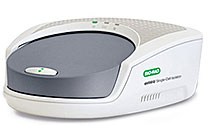Enables Genome-Wide Open Chromatin Sequencing at the Single-Cell Level

Bio-Rad harnesses its ddSEQ Single-Cell Isolator (pictured) to partition thousands of cell nuclei into individual nanoliter-sized droplets for library preparation.
HERCULES, Calif — September 19, 2018 — Bio-Rad Laboratories, Inc. (NYSE: BIO and BIOb) today announced the early access launch of its scATAC-Seq solution, a single-cell assay for transposase-accessible chromatin using sequencing. The solution harnesses Bio Rad’s ddSEQ Single-Cell Isolator to encapsulate thousands of cell nuclei into nanoliter-sized droplets, in which library preparation for chromatin sequencing occurs. The epigenomics solution enables genome-wide open chromatin sequencing at single-cell resolution.
Researchers studying regulatory biology are increasingly using single-cell gene expression tools such as ATAC-Seq to assess epigenetic differences by analyzing open chromatin regions and nucleosome positioning in regulatory regions and by identifying transcription factors. ATAC-Seq has a two-pronged advantage over other published methods because it does not require separate assays to collect this information, and it does not require millions of cells as starting material. The scATAC-Seq solution has given early access customers the power to study rare cell populations, thereby opening up new applications, such as the ability to study tumor heterogeneity or identify rare cell types in blood.
Bio-Rad’s scATAC-Seq solution enables genome-wide open chromatin sequencing at the single-cell level, leveraging the throughput capabilities of the company’s ddSEQ Single-Cell Isolator to partition thousands of cell nuclei, each into its own nanosized droplet. The solution’s sensitivity is achieved with a hyperactive transposase, which cuts the strands between the nucleosomes into very short fragments for greater resolution.
“The scATAC-Seq solution will specifically allow researchers to ask deeper questions about mechanisms of cell fate, identify the cell types present in heterogeneous tissues, and validate single-cell gene expression data,” said Dan Norton, Senior Product Manager for Bio-Rad’s Digital Biology Group.
In creating the scATAC-Seq solution, Bio-Rad used its expertise in droplets to produce a highly sensitive, high-throughput solution. The ddSEQ Single-Cell Isolator technology enables the processing of thousands of cells at once, in contrast to plate-based systems that can only handle 96 cells per plate. This throughput allows researchers to study immune and cancer cell biology at a deeper, more comprehensive level.
Bio-Rad will present data on how its scATAC-Seq solution enabled the discovery of a large repertoire of epigenomic regulatory elements involved in hematopoiesis and immune responses at the Single Cell Europe Conference in Prague on Friday.
Bio-Rad is sponsoring a Cell Press Webinar on October 10, where an inventor of ATAC-Seq and an early access customer, Jason Buenrostro, PhD, will present his work.
Please visit bio-rad.com/scATAC-Seq to learn more about Bio-Rad’s scATAC-Seq
About Bio-Rad
Bio-Rad Laboratories, Inc. (NYSE: BIO and BIOb) is a global leader in developing, manufacturing, and marketing a broad range of innovative products for the life science research and clinical diagnostic markets. With a focus on quality and customer service for over 65 years, our products advance the discovery process and improve healthcare. Our customers are university and research institutions, hospitals, public health and commercial laboratories, biotechnology, pharmaceutical, as well as applied laboratories that include food safety and environmental quality. Founded in 1952, Bio-Rad is based in Hercules, California, and has a global network of operations with more than 8,000 employees worldwide. Bio-Rad had revenues exceeding $2.1 billion in 2017. For more information, please visit www.bio-rad.com.
This release may be deemed to contain certain forward-looking statements within the meaning of the Private Securities Litigation Reform Act of 1995. These forward-looking statements include, without limitation, statements we make regarding our development and launch of new products and our expectations regarding our products. Forward-looking statements generally can be identified by the use of forward-looking terminology such as “will,” “plan”, “believe,” “expect,” “anticipate,” “may,” “can,” “intend,” “estimate,” “continue,” or similar expressions or the negative of those terms or expressions, although not all forward-looking statements contain these words. Such statements involve risks and uncertainties, which could cause actual results to vary materially from those expressed in or indicated by the forward-looking statements. These risks and uncertainties include our ability to develop and market new or improved products, product quality and liability issues, our ability to compete effectively, and international legal and regulatory risks. For further information regarding our risks and uncertainties, please refer to the “Risk Factors” and “Management’s Discussion and Analysis of Financial Condition and Results of Operation” in Bio-Rad’s public reports filed with the Securities and Exchange Commission, including our most recent Annual Report on Form 10-K and our Quarterly Report on Form 10-Q. Bio-Rad cautions you not to place undue reliance on forward-looking statements, which reflect an analysis only and speak only as of the date hereof. We disclaim any obligation to update these forward-looking statements.
Press Contact:
Bio-Rad Laboratories, Inc.
Carolyn Reifsnyder
925-474-9027
carolyn_reifsnyder@bio-rad.com
CG Life
Ken Li
312-532-4675
kli@cglife.com
